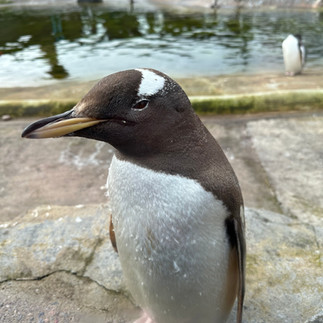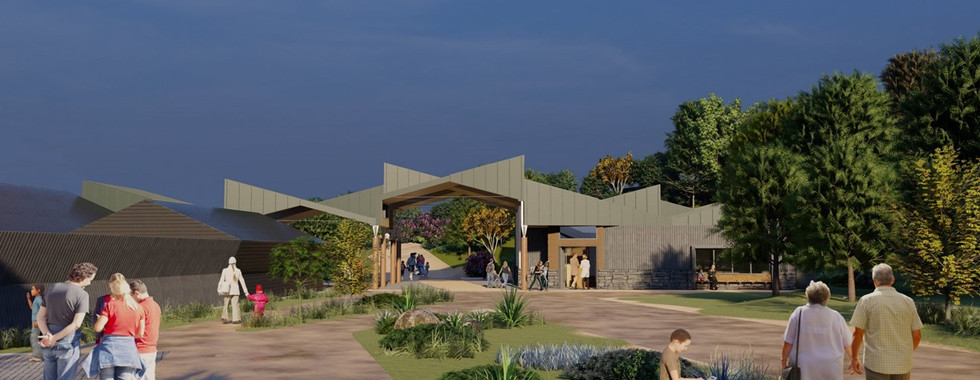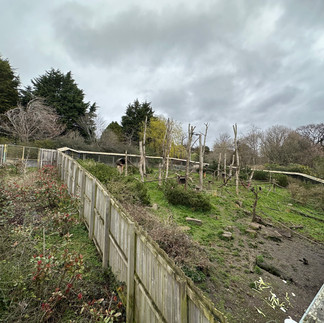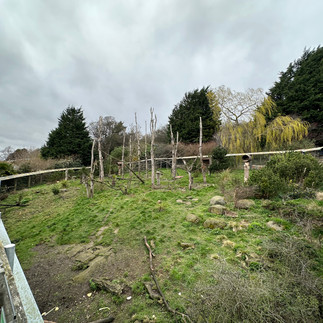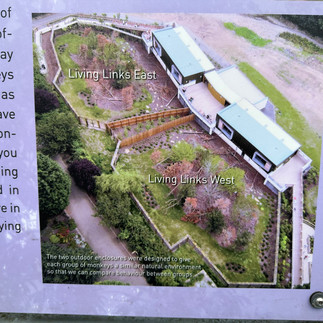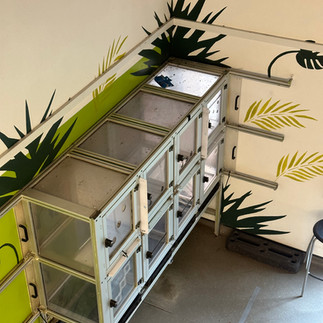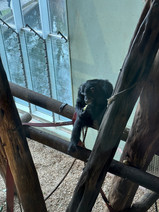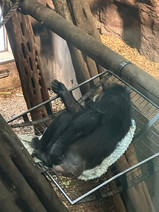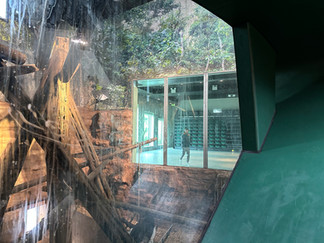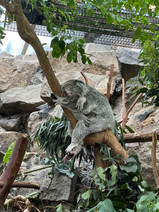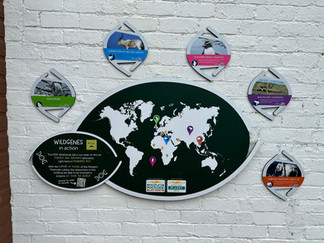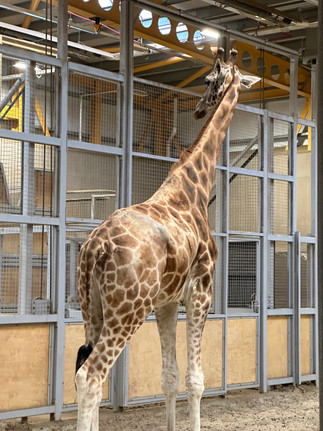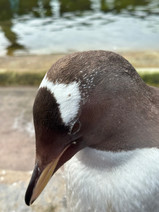A Royal Invitation - Edinburgh Zoo
- Bailey Tuddenham

- Apr 5, 2023
- 7 min read
Updated: Apr 17, 2023
I decided to reach out the the Royal Zoological Society of Scotland about my research project for D&T. They got back to me, and asked for some more details on my project, before putting me in touch with their Learning Technology Officer, Lizzie Seymour.
After a brief email exchange, Lizzie invited me to Edinburgh Zoo, where she's based, for a meeting about how technology is being utilised at the Royal Zoological Society of Scotland.
A date was set, and that date arrived! I set off in my car and drove down to Edinburgh. I had never been to Edinburgh Zoo before, so I was excited to have the chance to take a look around. But first, I headed for my meeting with Lizzie!

I arrived outside the building with half an hour to spare, so I spent a bit of time with the penguins. I've always loved a penguin, and they're one of the animals that I wish I had gotten to work with more at the Zoological Society of East Anglia.
The clock struck 11am, and I progressed inside for my meeting with Lizzie. She met me with a smile and a friendly handshake. We made our way to one of the classrooms at Edinburgh Zoo, where we sat down and began our meeting. Lizzie very kindly offered for me to record our conversation, which can be observed below!
Lizzie initially mentioned that her career revolves around conservation education, and that she may not be able to tell me a lot about RZSS's uses of technology outside of education. However, she ended up telling me a huge amount about technology inside and outside of conservation. She was full of information and told me way more than she thought she'd be able to!
Lizzie is the only Learning Technology Officer in a zoo in the UK, and one of only two in the world; the other residing in Lisbon. She was employed nearly 6 years ago in order to develop the use of digital and technological tools to benefit conservation education and learning at Edinburgh Zoo and the Highland Wildlife Park.
Below is an overview of the conversation we had (with timestamps), and what Lizzie told me about how RZSS are using technology for both conservation and conservation education, along with images that I took whilst walking around the zoo afterwards.
RZSS Uses of Technology In cONSERVATION EDUCATION
- (3:00) Looking into the impact of virtual reality (VR) on engagement and retention within conservation education. according to a recent research paper, virtual reality is currently assumed to be stored in the same part of the memory as real experiences, rather than things such as looking at pictures. RZSS are working with those researchers in order to see what impact it can have on conservation education.
- (3:46) Edinburgh Zoo have three classrooms in their Education Centre. One of these three classrooms is called the "Immersive Classroom". There's an array of projectors, motion sensors, fans and scent emitters placed around the room, which allow the whole room to be transformed into a digital space. Imagery can be projected onto the walls and floor to create an almost 360 degree environment. The addition of the scent emitters make the experiences even more immersive. The motion sensors then allow the children to interact with things on the wall, and immerse themselves first-hand with the surrounding environment. Each wall can take 10 touch points at a time. The idea is that the whole room can be transformed into things like a rainforest, where the children can learn about the animals moving around them, whilst listening to the sounds and noticing the smells. The children can also go and see an animal in the zoo and learn about how it's looked after in the zoo, then go into the immersive classroom and learn about the threats it's facing in the wild in a digital environment. It adds multiple touchpoints to the learning, and it's an incredible use of technology in order to encourage children to retain the education that they're receiving.

- (10:06) RZSS have a huge, online learning platform called ZOOdle. ZOOdle is a massive collection of online resources, such as games and printable sheets and educational topics, for learning about conservation. It is designed in a way that it can be used before and after a zoo visit, or just in your own time. The service is completely free, opening up the opportunity to learn about conservation to everyone. The website is currently averaging over 100,000 views per month, which shows just how successful the implementation of technology and digital learning has been to conservation education. An interesting point that Lizzie made regarding ZOOdle is that they not only made it free, but also made it completely open. This means that it doesn't require a login to access, which breaks the barrier or people not wanting to put in their details, or not feeling safe sharing their information online.

- (14:56) Lizzie mentioned a bit about how the RZSS are using 360 cameras in order to capture more immersive footage across the world. This footage is then being used in the immersive classroom, as well as being uploaded to ZOOdle for people to view at home. Members of staff are taking 360 cameras with them when they head off on international conservation efforts and then capturing a huge range of footage.
- (15:47) RZSS are working with a team in Brazil for research and education. The use of technology allows them to communicate and work together on a range of projects and share resources. There are currently talks of using technology in order to allow children from Scotland and Brazil to work together, digitally, on projects and learn from each other.
- (17:48) Edinburgh Zoo are aiming to invest more in technological signage around the park, including three new screens at the entrance. One use of these will be for practical things, such as showing the times of talks and events during the day. However, Lizzie is also very keen for them to show information on conservation and education, including information on why the zoo exists and what work they're carrying out within conservation. The use of technology in this way is much more engaging for the public than non-digital signage.
- (25:15) The RZSS are currently in the process of building "Scotland's Wildlife Discovery Centre". The project will be made up of three new buildings and new enclosures. Within the main, new building, there will be use of tablets with augmented reality in order to visualise animals walking around you, along with other technological uses. There will also be other immersive technologies, too. For example, there will be a giant pinecone in the centre of the room, which visitors can walk into and listen to sounds of animals and environments.
- (34:01) Edinburgh Zoo are looking to bring back an after school technology club that they used to run called "Tech Monkeys". The children would come in and use technology like Raspberry Pi to build things like camera traps.
RZSS Uses of Technology In cONSERVATION
- (18:31) Edinburgh Zoo has a series of enclosures called the Budongo Trail. The Budongo Trail is home to the zoos chimpanzees, and BRU (The Budongo Research Unit). BRU is a partnership with St Andrews University, where psychology students are currently carrying out research with the chimps to gain a better understanding of what they can understand, and of their minds. The majority of the research carried out in BRU are technological. For example, the chimps are sometimes presented with touch-screens, where they play memory games. One of the games displays a set of cards on the screen with numbers on them. The cards are then flipped over and the chimp has to tap the cards on the screen in the order of the numbers, from memory. Some of the chimps are able to remember orders upwards of 24 cards! There is another touch screen currently being set up outside BRU in the Budongo Trail where the public will be able to play the same games and compare their scores to the chimps.
- (20:41) The researchers in BRU are also looking into whether the chimpanzees can understand virtual reality, too. The chimps explore a 3d environment and have to navigate to a certain point in that environment. When they get to that point, the system releases a treat. The idea behind the VR research is to see whether the chimps can relate a real space to a virtual space.
- (21:10) Edinburgh Zoo has another research facility called Living Links, which is also in partnership with St Andrews University. Living Links is a pair of identical, mirrored enclosures (wings) which house capuchins and squirrel Monkeys. This allows researchers to implement or change something about one enclosure, and compare the impact on the capuchins and squirrel monkeys across both enclosures. Each wing has a technological research room where data is obtained and recorded. Edinburgh Zoo are also considering getting the public involved in the research by using digital tablets. The idea is to allow the public to observe both enclosures and make observations on what they can see using the tablets.
- (29:35) The RZSS have a laboratory, based at Edinburgh Zoo, called the WildGenes lab. Edinburgh Zoo is the only zoo in the UK that has an EAZA (European Association of Zoos and Aquariums) biobank (genetic samples of captive and wild animals for conservation purposes). The laboratory carries out research using technologies such as genetic sequencing in order to establish a wide variety of things, including establishing 'ultimate' pairings for mating. The WildGenes lab has also been able to establish the best diets for animals based on genetic research and technology, and is responsible for establishing the best guidelines for the diets of sumatran tigers across the globe.
- (34:54) This isn't something that the RZSS have been doing themselves, but Lizzie mentioned that some organisations use 'barcode scanners' in order to identify zebra, because all of their stripe patterns are unique. I found this quite fun and particularly interesting.
Thanks again to Lizzie Seymour for inviting me and taking the time to have a meeting to discuss this project! Next, I will look further into a couple of areas where the RZSS are utilising technology to aid in conservation.






